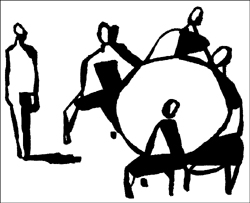 (Reprinted with permission from Studies in Higher Education, written by Angela Brew.)
(Reprinted with permission from Studies in Higher Education, written by Angela Brew.)
Academics work together in a great variety of ways. Yet what is the nature and scope of that collaboration? What are the factors that make for successful collaboration? To what extent is the need for collaboration growing and how can future collaboration be made more effective?
In Redesigning Collegiate Leadership: Teams and Teamwork in Higher Education, Estela Mara Bensimon and Anna Neumann draw from research among senior management teams in fifteen institutions of higher education in the United States. The authors argue that the traditional individual-centered view of leadership is based on male ways of thinking and acting. Borrowing from feminist literature, they suggest that leadership must be reconceptualized as a collective and interactive act, a team activity. The book examines the implications of viewing senior management teams as cultures and stresses the processes rather than the products of team activity. This reconceptualization is used to examine how different kinds of senior management teams function, which kinds of teams are effective in leading higher education institutions, what the difficulties are, and to give suggestions for how to achieve effective leadership.
Bensimon and Neumann distinguish three functions that senior management teams can perform. The “utilitarian” function is conceived as the rational achievement of the president or chief executive’s objectives. It is directed towards providing and sharing information, setting goals, and planning and taking decisions. The “expressive” function focuses more on the provision of mutual support. Presidents who stress the expressive function tend to use their teams as a sounding board for ideas and to get support for their ideas and actions. The third function defined by Bensimon and Neumann is the team’s “cognitive” function; each team member brings together different ideas and views. It involves team members questioning and arguing as well as monitoring and feeding back ideas to and from the wider university community.
Senior management teams in higher education differ in the extent to which they use these functions. However, the case for the need for teams to use all the functions is well made.
Bensimon and Neumann distinguish eight roles to be performed within each team. Some provide the core of the team’s thinking; others support the core. So, for example, the “definer” defines the team’s reality, the “analyst” provides an analysis of the previously defined reality, the “interpreter” translates that reality in terms of what those outside will think. The “critic” offers redefinitions or new interpretations of issues, and the “synthesizer” brings the ideas together. To support these roles, the “disparity monitor” assesses how those outside the team are likely to make sense of the team’s actions. The “task monitor” attempts to remove obstacles to the team’s thinking and the “emotional monitor” looks after the personal and emotional context in which the team’s thinking and activity is taking place. Team members perform different roles at different times. The authors argue that for the team to be effective, as many of the roles as possible should be played.
The authors’ suggestions as to how teams can be redesigned include developing the ability of team members to understand the subjective experience of other people, developing their ability to share and interact, their ability to be critical, and their ability to reflect and learn through critical reflection.
I think the book could have an impact not so much with existing teams as with the teams of the future. If there are training courses for aspiring senior managers, this book should be on the reading lists. It should be of interest to all who have wondered what goes on in the senior management team in their particular institution of higher education.



























